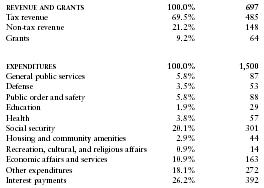Albania - Public finance
Albania began its transition from a centrally-planned economy to a market driven economy in 1992, after GDP had collapsed by over 50% in 1989. The government elected in 1992 set in motion a series of aggressive economic reforms to light the path towards a market economy. Among the reforms were price and exchange regime liberalization, fiscal consolidation, monetary restraint, and a rigid income policy. Stalling progress in 1997 was followed by a resumption of growth the next year.
The US Central Intelligence Agency (CIA) estimates that in 2002 Albania's central government took in revenues of approximately $697 million and had expenditures of $1.5 billion including capital expenditures of $368 million. Overall, the government registered a deficit of approximately $803 million. External debt totaled $784 million.
The following table shows an itemized breakdown of government revenues and expenditures. The percentages were calculated from data reported by the International Monetary Fund. The dollar amounts (millions) are based on the CIA estimates provided above.

| REVENUE AND GRANTS | 100.0% | 697 |
| Tax revenue | 69.5% | 485 |
| Non-tax revenue | 21.2% | 148 |
| Grants | 9.2% | 64 |
| EXPENDITURES | 100.0% | 1,500 |
| General public services | 5.8% | 87 |
| Defense | 3.5% | 53 |
| Public order and safety | 5.8% | 88 |
| Education | 1.9% | 29 |
| Health | 3.8% | 57 |
| Social security | 20.1% | 301 |
| Housing and community amenities | 2.9% | 44 |
| Recreation, cultural, and religious affairs | 0.9% | 14 |
| Economic affairs and services | 10.9% | 163 |
| Other expenditures | 18.1% | 272 |
| Interest payments | 26.2% | 392 |
Comment about this article, ask questions, or add new information about this topic: